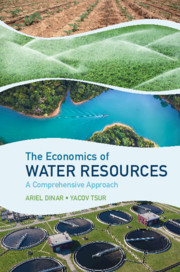Book contents
- The Economics of Water Resources
- The Economics of Water Resources
- Copyright page
- Contents
- Figures
- Tables
- Acknowledgments
- Introduction and Outlook
- Chapter 1 The State of Water Resources and the Need for a Comprehensive Perspective
- Chapter 2 The Water Economy
- Chapter 3 Supply Costs, Demands and Benefits
- Chapter 4 Optimal Water Policy
- Chapter 5 Water Regulation
- Chapter 6 Accounting for Uncertain Water Supplies
- Chapter 7 Case Studies of Regulatory Interventions
- Chapter 8 Economy-Wide Considerations of Water Management
- Chapter 9 Management of Transboundary Waters
- Index
- References
Chapter 4 - Optimal Water Policy
Published online by Cambridge University Press: 21 April 2021
- The Economics of Water Resources
- The Economics of Water Resources
- Copyright page
- Contents
- Figures
- Tables
- Acknowledgments
- Introduction and Outlook
- Chapter 1 The State of Water Resources and the Need for a Comprehensive Perspective
- Chapter 2 The Water Economy
- Chapter 3 Supply Costs, Demands and Benefits
- Chapter 4 Optimal Water Policy
- Chapter 5 Water Regulation
- Chapter 6 Accounting for Uncertain Water Supplies
- Chapter 7 Case Studies of Regulatory Interventions
- Chapter 8 Economy-Wide Considerations of Water Management
- Chapter 9 Management of Transboundary Waters
- Index
- References
Summary
The chapter characterizes the optimal water policy, i.e., the feasible policy (under physical, institutional, and budgetary constraints) that generates the highest payoff (social welfare) to the water economy. The optimal policy involves water allocations from the different sources to the different sectors/users and the investments in infrastructure needed to carry out these allocations. It is shown that the optimal policy begins with an infrastructure construction stage (which is usually short), followed by a turnpike stage that eventually converges to a steady state, during which water allocations, capital stocks, and investment rates remain constant over time.
- Type
- Chapter
- Information
- The Economics of Water ResourcesA Comprehensive Approach, pp. 75 - 93Publisher: Cambridge University PressPrint publication year: 2021

